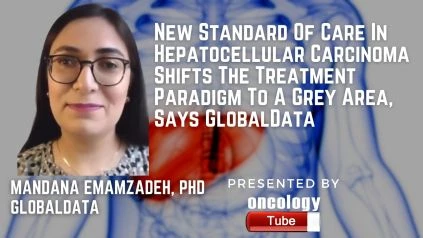Mandana Emamzadeh, Ph.D., Pharma Analyst at GlobalData speaks about New Standard Of Care In Hepatocellular Carcinoma Shifts The Treatment Paradigm To A Grey Area, Says GlobalData.
Link to Article:
https://www.globaldata.com/new-standard-care-hepatocellular-carcinoma-shifts-treatment-paradigm-grey-area-says-globaldata/
According to GlobalData, a leading data, and analytics firm, the approval of Roche’s Avastin (bevacizumab) plus Tecentriq (atezolizumab), in addition to the long list of pipeline drugs, opens up holes in the care model about the sequence of treatments.
Mandana Emamzadeh, Ph.D., Pharma Analyst at GlobalData, comments, “The hepatocellular carcinoma (HCC) market is evolving swiftly after the May 2020 FDA approval of Roche’s Avastin (bevacizumab) + Tecentriq (atezolizumab). The combination replaced the prior standard of care, Bayer’s Nexavar (sorafenib), in first-line (1L) treatment, resulting in an emerging grey area in sequencing where there are no data available for second-line (2L) and third-line (3L) treatments. The available 2L, and thus 3L, therapies are indicated for patients previously treated with Nexavar. Therefore, a study to investigate the sequence for patients who fail Avastin + Tecentriq in 1L is needed. “
As all have been studied after treatment with Nexavar, key opinion leaders (KOLs) interviewed by GlobalData addressed the lack of evidence for successful therapies after Avastin + Tecentriq. They also stated that the influx of new entrants with novel mechanisms of action (MOAs) in 1L — such as immuno-oncology (IO) monotherapies, IO plus Avastin, a vascular endothelial growth factor (VEGF) inhibitor, IO plus tyrosine kinase inhibitors (TKI), and dual IO inhibition through programmed cell death 1 (PD-1) or programmed death ligand 1 (PD-L
Emamzadeh continues: “In addition to the gap in data for the selection of 2L and 3L advanced therapies, there will be a further lack of data in the sequence of treatments as patients progress through stages of HCC. Currently, patients only receive systemic therapy from the advanced stage and not in the prior settings. However, label expansions of systemic therapy into earlier settings may change this, whereby patients may receive IO drugs as an adjuvant treatment or in addition to locoregional therapy. For instance, there are several pipeline drugs in Phase III clinical development with a variety of MOAs in adjuvant settings, using IO or IO in addition to Avastin. In the intermediate setting are trials combining trans-arterial chemoembolization (TACE) with IO therapies, IO plus Avastin, dual IO inhibition, or IO plus TKI. Consequently, the choice of treatment is expected to expand throughout the HCC treatment paradigm, from adjuvant to advanced settings. Therefore, the patients might develop resistance to IO therapies in the earlier stages of HCC, rendering them ineffective in the advanced stage and limiting treatment options in the latter setting.†However, KOLs remarked that re-treatment with the same MOA depends on the time frame from the end of the prior line of therapy to recurrence, where a long duration may allow for re-treatment.
The sequencing issue does not apply only to 1L, 2L, and 3L advanced-stage HCC therapy, but also to earlier stages and later stages of HCC. As a consequence, research is critical in determining the order and superiority of new entrants in each environment.

